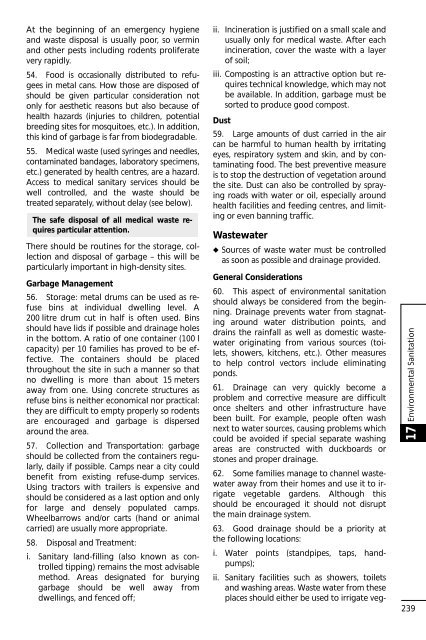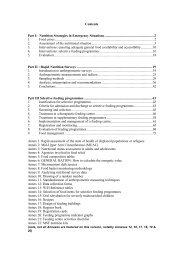UNHCR Handbook for Emergencies - UNHCR eCentre
UNHCR Handbook for Emergencies - UNHCR eCentre
UNHCR Handbook for Emergencies - UNHCR eCentre
You also want an ePaper? Increase the reach of your titles
YUMPU automatically turns print PDFs into web optimized ePapers that Google loves.
At the beginning of an emergency hygiene<br />
and waste disposal is usually poor, so vermin<br />
and other pests including rodents proliferate<br />
very rapidly.<br />
54. Food is occasionally distributed to refugees<br />
in metal cans. How those are disposed of<br />
should be given particular consideration not<br />
only <strong>for</strong> aesthetic reasons but also because of<br />
health hazards (injuries to children, potential<br />
breeding sites <strong>for</strong> mosquitoes, etc.). In addition,<br />
this kind of garbage is far from biodegradable.<br />
55. Medical waste (used syringes and needles,<br />
contaminated bandages, laboratory specimens,<br />
etc.) generated by health centres, are a hazard.<br />
Access to medical sanitary services should be<br />
well controlled, and the waste should be<br />
treated separately, without delay (see below).<br />
The safe disposal of all medical waste requires<br />
particular attention.<br />
There should be routines <strong>for</strong> the storage, collection<br />
and disposal of garbage – this will be<br />
particularly important in high-density sites.<br />
Garbage Management<br />
56. Storage: metal drums can be used as refuse<br />
bins at individual dwelling level. A<br />
200 litre drum cut in half is often used. Bins<br />
should have lids if possible and drainage holes<br />
in the bottom. A ratio of one container (100 l<br />
capacity) per 10 families has proved to be effective.<br />
The containers should be placed<br />
throughout the site in such a manner so that<br />
no dwelling is more than about 15 meters<br />
away from one. Using concrete structures as<br />
refuse bins is neither economical nor practical:<br />
they are difficult to empty properly so rodents<br />
are encouraged and garbage is dispersed<br />
around the area.<br />
57. Collection and Transportation: garbage<br />
should be collected from the containers regularly,<br />
daily if possible. Camps near a city could<br />
benefit from existing refuse-dump services.<br />
Using tractors with trailers is expensive and<br />
should be considered as a last option and only<br />
<strong>for</strong> large and densely populated camps.<br />
Wheelbarrows and/or carts (hand or animal<br />
carried) are usually more appropriate.<br />
58. Disposal and Treatment:<br />
i. Sanitary land-filling (also known as controlled<br />
tipping) remains the most advisable<br />
method. Areas designated <strong>for</strong> burying<br />
garbage should be well away from<br />
dwellings, and fenced off;<br />
ii. Incineration is justified on a small scale and<br />
usually only <strong>for</strong> medical waste. After each<br />
incineration, cover the waste with a layer<br />
of soil;<br />
iii. Composting is an attractive option but requires<br />
technical knowledge, which may not<br />
be available. In addition, garbage must be<br />
sorted to produce good compost.<br />
Dust<br />
59. Large amounts of dust carried in the air<br />
can be harmful to human health by irritating<br />
eyes, respiratory system and skin, and by contaminating<br />
food. The best preventive measure<br />
is to stop the destruction of vegetation around<br />
the site. Dust can also be controlled by spraying<br />
roads with water or oil, especially around<br />
health facilities and feeding centres, and limiting<br />
or even banning traffic.<br />
Wastewater<br />
◆ Sources of waste water must be controlled<br />
as soon as possible and drainage provided.<br />
General Considerations<br />
60. This aspect of environmental sanitation<br />
should always be considered from the beginning.<br />
Drainage prevents water from stagnating<br />
around water distribution points, and<br />
drains the rainfall as well as domestic wastewater<br />
originating from various sources (toilets,<br />
showers, kitchens, etc.). Other measures<br />
to help control vectors include eliminating<br />
ponds.<br />
61. Drainage can very quickly become a<br />
problem and corrective measure are difficult<br />
once shelters and other infrastructure have<br />
been built. For example, people often wash<br />
next to water sources, causing problems which<br />
could be avoided if special separate washing<br />
areas are constructed with duckboards or<br />
stones and proper drainage.<br />
62. Some families manage to channel wastewater<br />
away from their homes and use it to irrigate<br />
vegetable gardens. Although this<br />
should be encouraged it should not disrupt<br />
the main drainage system.<br />
63. Good drainage should be a priority at<br />
the following locations:<br />
i. Water points (standpipes, taps, handpumps);<br />
ii. Sanitary facilities such as showers, toilets<br />
and washing areas. Waste water from these<br />
places should either be used to irrigate veg-<br />
Environmental Sanitation<br />
17<br />
239



